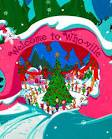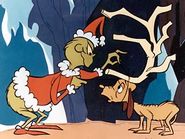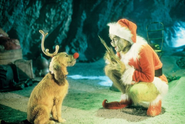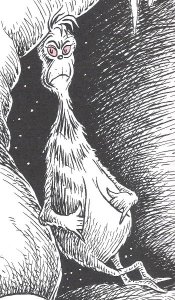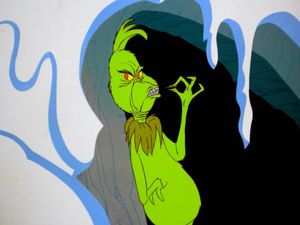Setting of Dr. Seuss’s How The Grinch Stole Christmas
By: Iyari Padilla Hernandez
“From there to here and here to there. Funny things are everywhere.” Dr. Seuss
The play How The Grinch Stole Christmas is set in the winter season. It takes place in the town of Who-Ville, which is a tiny speck located on a snowflake. Who-Ville is a curious and interesting place where people called Whos live. The Whos come in all shapes and sizes. Some Whos are big and tall while others are very small. They all love and enjoy celebrating the Christmas time season.
North of Who-Ville is a very tall mountain. This mountain is known as Mount Crumpit. It is three thousand feet high, icy cold and foggy. In one of Mount Crumpit’s caves lives the Grinch and his dog Max. The Grinch’s cave overlooks Who-Ville and he can see and hear the Whos. The Grinch does not like Christmas or anything else that has to do with the jolly holiday. After fifty-three years of listening to the Whos celebrations of Christmas in Who-Ville the Grinch has finally had enough.
Max the dog is young when the Grinch decides to put a stop to Christmas. Max is the narrator of the play. He is now an old dog and is telling the story of what happened when the Grinch stole Christmas.
Fun Facts:
-The Grinch was originally black and white with pinkish splotches when Dr. Seuss first illustrated him in his book. The Grinch was not made green until the animated cartoon How the Grinch Stole Christmas in 1966 (9 years after the book came out).
-The animated cartoon How the Grinch Stole Christmas was adapted by Chuck Jones in 1966. Mr. Jones was also the director and animator behind the Looney Tunes cartoons with such characters as Bugs Bunny, Daffy Duck, Porky Pig and many other famous cartoon characters.
– The live action movie How the Grinch Stole Christmas (2000) had many hidden Seuss things from other stories (such as green eggs and ham, and a Horton the elephant statue). If you watch the 2000 film, see if you can catch any of the hidden Seuss items.
***** CCSS.ELA-Literacy. RL. 4.3. *****
Jennings, Coleman A. “Dr Seuss How The Grinch Stole Christmas.” Theatre for Children: Fifteen Classic Plays. New York: St. Martin’s, 2005. 58-84. Print
“Dr. Seuss Wiki.” Dr. Seuss Wiki. Web. May 2015. <http://seuss.wikia.com/wiki/Dr._Seuss_Wiki >.
“How the Grinch Stole Christmas!” IMDb. IMDb.com. Web. May 2015 <http://www.imdb.com/title/tt0060345/?ref_=nv_sr_2 >. (1966 TV special) <http://www.imdb.com/title/tt0170016/?ref_=nv_sr_1 >. (2000 movie)
EVENT ON WHICH IT FOCUSES
By Jason Abad
Understanding Christmas:
How the Grinch Stole Christmas is a play which revolves around the Christmas season and holiday. To talk about Christmas is to talk about many very different sets of traditions. Christmas today is very different from Christmas at the end of the 19th century—just before 1900—and Christmas in the 1900’s would be completely indistinguishable from what it was before that. From its origins as a variety of ancient traditions and cultural connections it has been appropriated by various cultures around the world. Some of the traditions that we practice–that are visible within How the Grinch Stole Christmas–are quite different in different locations across the world.
Christmas Today:
The Modern Concept of Christmas is one which brings to mind generous swaths of red and green decoration amid a wintery snowscape. Santa Claus, Reindeer, Presents, Caroling, Christmas Trees—ornamented with festive baubles, lights and tinsel—, and a great number of other icons are instantly associated with the holiday. Some associations are religious, but others are not. The one thing which all of these things have in common is that they are festive or a celebration. The word carol—a word associated with Christmas—literally refers to singing for enjoyment.5 For comparison, the word hymn refers to singing to give praise or worship.5 So, even in a very religious sense, Christmas is a festive time of enjoyment. It is a time to enjoy family, friends, and many other things. That is the idea that has transcended all the ways that Christmas has changed over the years–that Christmas is a time to be festive or to celebrate something.

Christmas today is much like Christmas in the 1950’s. It revolves around a family and for the most part is not a community event; however, there are differences between the family structure of today and that of the 1950’s.4 Up until about the 1980’s a large percentage of familial structures within the United States were traditional–two parents, two point five children, and a dog or cat.4 The percentage of families that live that lifestyle is now down to around 46 percent.4 The remaining families include families with a single parent, unmarried parents, stepparents, and extended families.4 This makes Christmas a bit different than what it was in the 1950’s. It is becoming increasingly varied from family to family with each possessing their own particular traditions that have been influenced by the lifestyle that they live.4 Many families celebrate Christmas multiple times at either with a separate parent or extended family.4 The increasingly inclusive nature of Christmas may in some ways be more appropriate to the story of How the Grinch Stole Christmas.

Christmas in the time of the Greeks:
One of the earliest times that we can trace back to and find elements of “Christmas” is to the time of the Greeks some time before the year 500 AD2—so in other words, a very long time ago. In that time, there existed a festival that celebrated the winter season.2 In that season girls would celebrate their coming of age2—much like people today celebrate a graduation or a birthday. It was a time that was surrounded by Greek myth. Many of the Greek deities were involved. The festival revolved around Artemis.2 Many believed that Artemis was the protector of young girls and women.2 Eventually, Christianity spread and these legends retreated behind the curtain of myth, but people still celebrated the winter season.2 They even still held dear a figure that would safeguard young girls, but instead of young girls the legend would include all children2—and for people today, all children of the world. This was a kind monk who we know today as St. Nicholas. As time moved on, the world would later know of this man as Santa Claus—the jolly man traversing the rooftops of the good children of the world and serving as moral compass to those same children.
Christmas in Scandinavia:
More than 2000 years ago, Scandinavians also had in a midwinter celebration. The name of this celebration is one which people still recognize today—Yule.1 There are many places where this word is still seen. There is a Yule Log.1 Christmas songs or stories, including How the Grinch Stole Christmas refer to the season as Yuletide. There are even references to Yule which are seen in different parts of the world such as a Yule Goat.1 At this time of the year, Scandinavians would celebrate the return of the sun.1 This was a very cold time of year in a very cold climate.1 The first sign of warming was understandably important. Fathers and sons would bring back a very large log, and everyone would feast until the log burned out.1 There was no refrigeration so feasts were more common forms of celebration in the time before refrigeration. In many parts of the world, it was also difficult to feed large animals through the winter. The feast would lessen this burden in a time when food was scarce.1
The Yule Goat, Caroling and Feasting:
The Scandinavian Yule and the Yule Goat have another connection to How the Grinch Stole Christmas. The Yule Goat was an early reindeer. It was the animal that helped Father Christmas, an early Santa, deliver presents.6 It was also the animal that was used for their seasonal dinner and marked gratitude for a good year.6 There are even some who dressed up with goat masks and traveled from door to door.6 The furthest this practice can be traced is to that of Norse Mythology.6 The two goats who pulled the cart of Thor are the origin for this figure which would later be transformed into the goat headed figures singing carols from door to door.6
The Yule Goat Now:
In recent times this figure has grown from its mythic proportions—in more than one manner of speaking.

Gävlebocken or the Gävle Goat is a giant goat that one town has created in the spirit of the Yule Goat for the celebration of Yule Season.3 The town has created this tradition of constructing this 42 foot tall goat over the period of many years.3
Over the years another curious tradition has also taken place which leaves the goat in some way shape or form in ruins before the end of the Yule season3—a Yule groundhog almost. The goat has been burned down many times.3 It’s even been hit by a car and kidnapped by helicopter.3

The town has attempted over the course of the year to protect Gävlebocken.3 One year they built a giant fence.3 It was shot with flaming arrows.3 When asked why the town continues to resurrect this goat, they simply respond, “We like the goat.”3
Wassailing/Caroling and the Christmas “Marti Gras”:
Caroling as it is known today originated from Wassailing which became a tradition in England in the Middle Ages from Germanic traditions.6 It is important to understand that the etymology–the origin of–the word carol is that of a song sung for enjoyment.5 It can be then understood that this tradition as the word suggests is rooted around the enjoyment of the carolers in the spirit of the season. In fact, the activities of this “raucous” holiday was enjoyed so much that the drunken revelry was outlawed in the 17th century when the puritans under Oliver Cromwell gained control over the English government.1 The family oriented nature of Christmas today is a relatively new idea. The celebratory event was closer to that of Marti Gras. The act of caroling actually involved revelers going door to door seeking seasonal drink–whether clothed in 17th century English celebratory garb or the festive goat mask of Norse mythological origin.
Common Core Standards
CCSS.ELA-LITERACY. RL. 4.3.
CCSS.ELA-LITERACY. RL. 4.4.
Works Cited
1 “History of Christmas.” History. Web. 25 Apr. 2015.
2 Curtis, Bruce. “The Strange Birth of Santa Claus: From Artemis the Goddess and Nicholas the Saint.” Journal of American Culture. (2004):18.4. 17-29. Web. 25 Apr. 2015.
3 Innskeep, Steve. “In Sweedish Town, Straw Goat for Advent Often Meets Fiery End. NPR. 1 Dec. 2014. Web. 25 Apr. 2015.
4 Marcotte, Amanda. “Non-Traditional Families are the New Tradition.” Slate. 24 Dec. 2014. Web. 29 Apr. 2015.
6 Rossel, Sven. "Introduction" Christmas in Scandinavia. n. pag. EPUB.
5 Tulloch, A. (2009). Christmas. English Today, 25(4), 61-63. Web. 27 Apr.2015.
